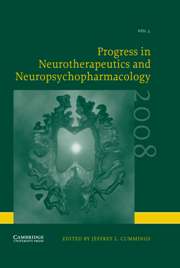No CrossRef data available.
Article contents
A Double-Blind, Randomized Clinical Trial to Assess the Augmentation with Nimodipine of Antidepressant Therapy in the Treatment of “Vascular Depression”
Published online by Cambridge University Press: 21 July 2006
Extract
ABSTRACT
There is evidence for an association between vascular disease and depression, and in particular between cerebrovascular disease and depression, especially that occurring later in life. Among the diverse psychiatric diseases, the one which is most widely studied concerning the relationship with the vascular system, is depression. The risk relationship between depression and vascular events is a two-way road: the presence of depression increases the cerebrovascular and cardiovascular event risk (worsening its evolution and prognosis, as well) and a patient evidencing cerebrovascular or heart disease, will also show an increase in the risk of suffering depression (Taragano et al., 2005). Depression is a common cause of disability in the elderly. It reduces quality of life and represents a serious public health problem (Beekman et al., 2001; Steffens et al., 2000). Its prevalence in late life is 2–3% for major depression and 12–15% for all depressive syndromes (Beekman et al., 1999).
Keywords
- Type
- Review Article
- Information
- Progress in Neurotherapeutics and Neuropsychopharmacology , Volume 2 , Issue 1 , March 2007 , pp. 137 - 154
- Copyright
- © 2007 Cambridge University Press




